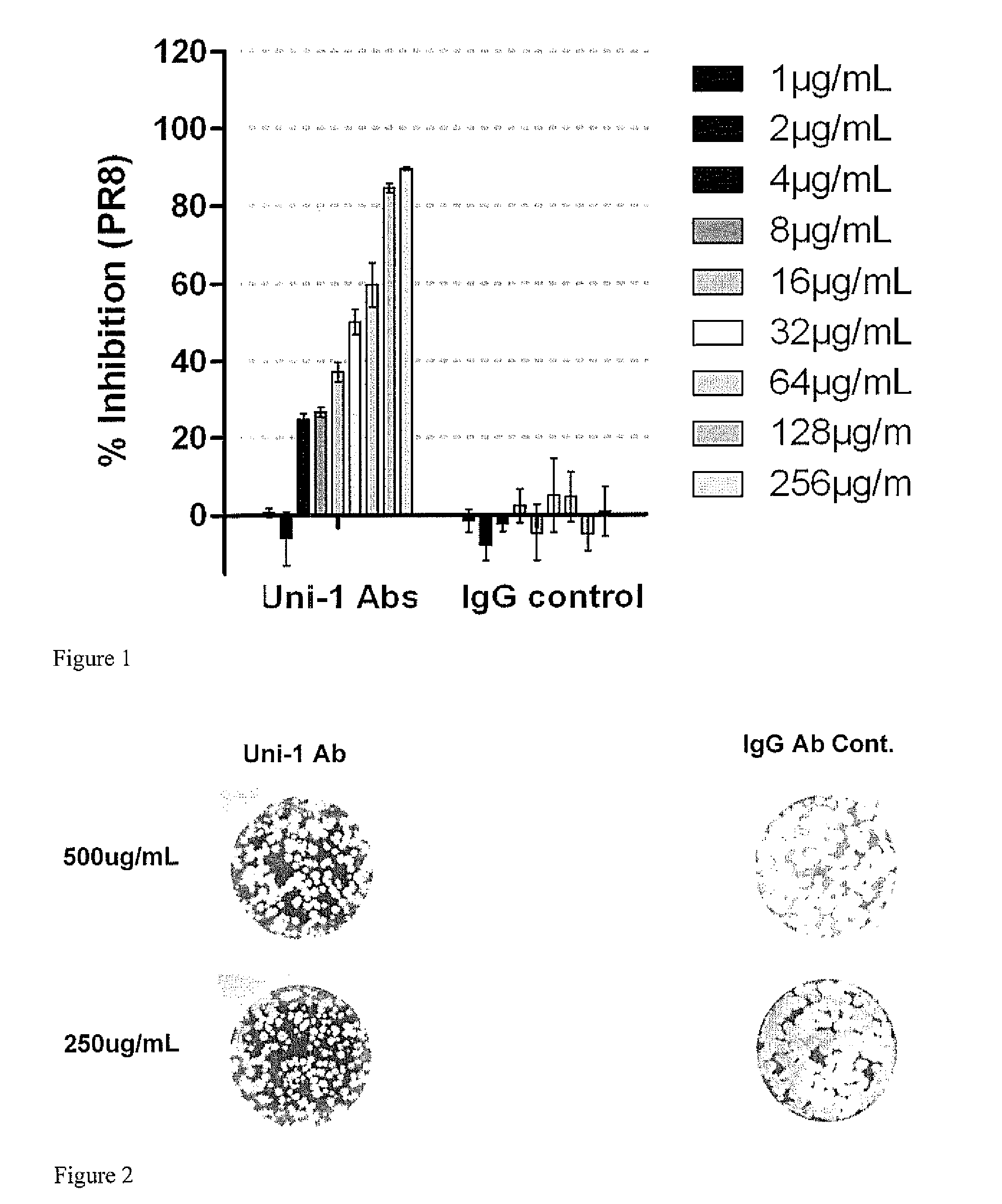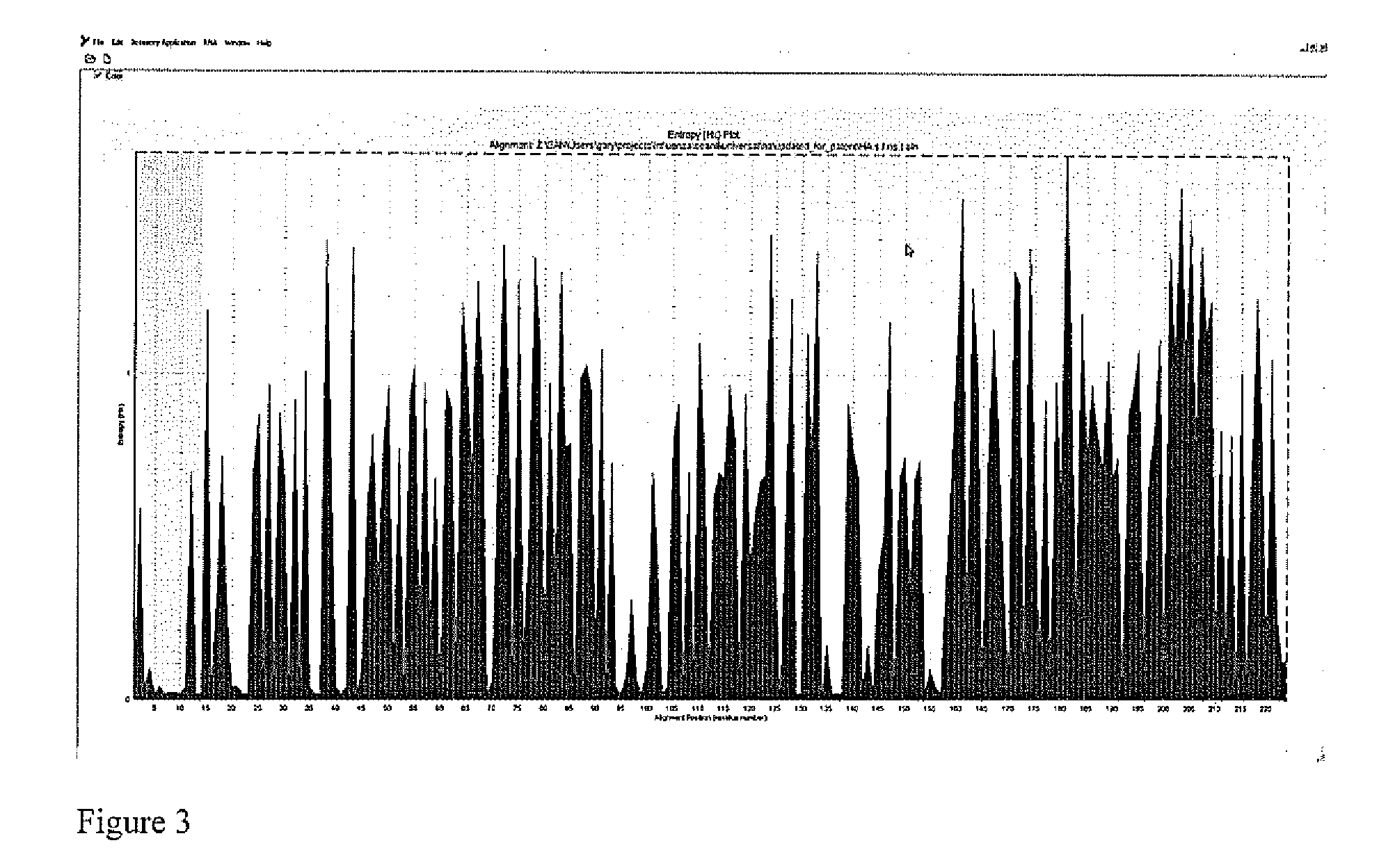Influenza vaccine
a technology for influenza and vaccines, applied in the field of influenza vaccines, can solve the problems of reducing the efficacy of seasonal influenza vaccines, the need for annual updating of manufacturing processes and preparation of reagents, and the uncertainty of actual effects
- Summary
- Abstract
- Description
- Claims
- Application Information
AI Technical Summary
Benefits of technology
Problems solved by technology
Method used
Image
Examples
example 1
[0041]All (12,451) HA Inf A protein sequences from, avian, human, and swine hosts full sequences, including 2009 pandemic sequences were downloaded from the NCBI flu resource database on Apr. 13, 2010. The sequences were then filtered such that only sequences representing a unique combination of host, location, subtype, and collection year were selected in order to reduce overrepresentation of strains collected in a given region at a given time. This reduces the set to 1905 sequences. Sequences containing ambiguity codes (BJOUXZ) were removed from the set, reducing the total to 1843. Unusually short sequences were also removed from the set, giving a final number of 1068 sequences for analysis. Sequences were multiply aligned using clustalw-mpi.
[0042]The sequences from ncbi are the immature polyprotein sequences; this poly protein is cleaved when mature into two ha sequences: ha1 and ha2. The fusion peptide resides at the N-terminus of HA2, the alignment was then edited such that the...
example 2
Preparation of Peptides and their Conjugates for Immunization
[0044]Bioinformatics approach was employed to locate the presence of the universally conserved region in the HAs. Sequences from public domains (the NCBI flu resource) were retrieved separately for each subtype. The combined human and avian influenza HA sequences with identical sequences were removed. Next, a separate multiple alignment for each subtype was performed, followed by the extraction of the target region from the full-gene alignment. The Shannon entropy for each position of amino acid of the identified consensus sequences was then calculated to determine the degree of variation. Four peptides were selected to ensure a good coverage of the fusion peptide region. These peptides, GLFGAIAGFIEGGW (SEQ ID NO: 1) (UnM); GIFGAIAGFIEGGW (SEQ ID NO: 2) (Uni-2); GLFGAIAGFIENGW (SEQ ID NO: 3) (Uni-3); and GIFGAIAGFIENGW (SEQ ID NO: 4) (Uni-4), were then modified and conjugated in a procedure described previously with minor ...
example 3
Generation of Vaccine by Immunizing with Peptide
[0046]Rabbits and sheep were immunized with peptide of sequence GLFGAIAGFIEGGW (SEQ ID No. 1) conjugated to 6-aminocaproic acid spacer, and a tripeptide (KKC) and a protein carrier (KLH) according to standard techniques and antibodies isolated by affinity chromatography. Antibodies that recognized a number of influenza strains were identified. These antibodies bound to hemagluttinins from multiple strains of influenza as shown in western blots.
Production of Antibodies Against the Fusion Peptides of HAs
[0047]NZW rabbits were obtained from Jackson Laboratory. All animal experiments were conducted in accordance with the Institutional Guidelines and Protocols for Animal Experiments. The animals were immunized subcutaneously with peptide of sequence GLFGAIAGFIEGGW (SEQ ID No. 1) conjugated to 6-aminocaproic acid spacer, and a tripeptide (KKC) and a protein carrier (KLH) mixed with freund complete adjuvant (FCA) at 200 μg per injection, and ...
PUM
 Login to View More
Login to View More Abstract
Description
Claims
Application Information
 Login to View More
Login to View More - R&D
- Intellectual Property
- Life Sciences
- Materials
- Tech Scout
- Unparalleled Data Quality
- Higher Quality Content
- 60% Fewer Hallucinations
Browse by: Latest US Patents, China's latest patents, Technical Efficacy Thesaurus, Application Domain, Technology Topic, Popular Technical Reports.
© 2025 PatSnap. All rights reserved.Legal|Privacy policy|Modern Slavery Act Transparency Statement|Sitemap|About US| Contact US: help@patsnap.com


